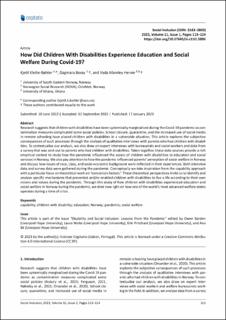| dc.contributor.author | Bøhler, Kjetil Klette | |
| dc.contributor.author | Bossy, Dagmara | |
| dc.contributor.author | Hervie, Vyda Mamley | |
| dc.date.accessioned | 2024-01-19T08:22:00Z | |
| dc.date.available | 2024-01-19T08:22:00Z | |
| dc.date.created | 2023-01-17T15:39:47Z | |
| dc.date.issued | 2023 | |
| dc.identifier.citation | Social Inclusion. 2023, 11 (1), . | en_US |
| dc.identifier.issn | 2183-2803 | |
| dc.identifier.uri | https://hdl.handle.net/11250/3112652 | |
| dc.description.abstract | Research suggests that children with disabilities have been systemically marginalised during the Covid‐19 pandemic as con‐
tamination measures complicated some social policies. School closure, quarantine, and the increased use of social media
in remote schooling have placed children with disabilities in a vulnerable situation. This article explores the subjective
consequences of such processes through the analysis of qualitative interviews with parents who had children with disabil‐
ities. To contextualise our analysis, we also draw on expert interviews with bureaucrats and social workers and data from
a survey that was sent out to parents who had children with disabilities. Taken together, these data sources provide a rich
empirical context to study how the pandemic influenced the access of children with disabilities to education and social
services in Norway. We also pay attention to how the pandemic influenced parents’ perception of social welfare in Norway
and discuss how issues of race, class, and socio‐economic background were reflected in their experiences. Both interview
data and survey data were gathered during the pandemic. Conceptually we take inspiration from the capability approach
with a particular focus on theoretical work on “conversion factors.” These theoretical perspectives invite us to identify and
analyse specific mechanisms that prevented and/or enabled children with disabilities to live a life according to their own
visions and values during the pandemic. Through this study of how children with disabilities experienced education and
social welfare in Norway during the pandemic, we shed new light on how one of the world’s most advanced welfare states
operates during a time of crisis. | en_US |
| dc.language.iso | eng | en_US |
| dc.rights | Navngivelse 4.0 Internasjonal | * |
| dc.rights.uri | http://creativecommons.org/licenses/by/4.0/deed.no | * |
| dc.title | How Did Children With Disabilities Experience Education and Social Welfare During Covid-19? | en_US |
| dc.type | Peer reviewed | en_US |
| dc.type | Journal article | en_US |
| dc.description.version | publishedVersion | en_US |
| cristin.ispublished | true | |
| cristin.fulltext | original | |
| cristin.qualitycode | 1 | |
| dc.identifier.doi | 10.17645/si.v11i1.5896 | |
| dc.identifier.cristin | 2108787 | |
| dc.source.journal | Social Inclusion | en_US |
| dc.source.volume | 11 | en_US |
| dc.source.issue | 1 | en_US |
| dc.source.pagenumber | 12 | en_US |

